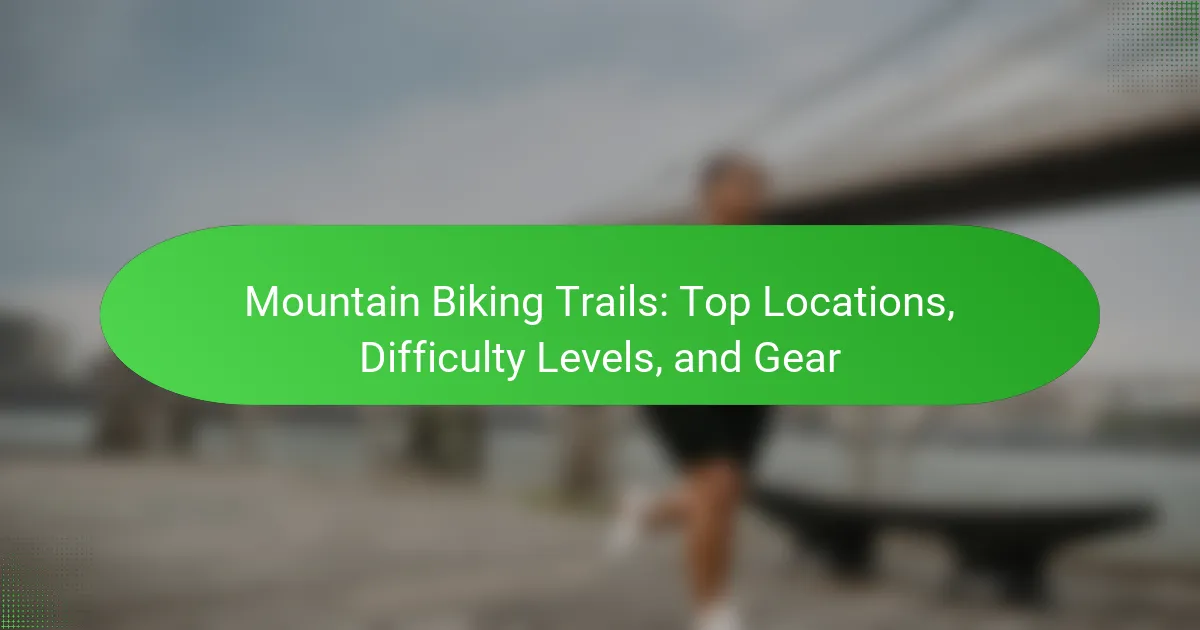Finding the right mountain biking trail can enhance your riding experience and challenge your skills. Explore top locations like Whistler Bike Park and Moab, understand varying difficulty levels, and discover essential gear for a safe ride. Learn how terrain, elevation, and technical features influence trail selection, and prepare effectively for your next biking adventure.

What are the top mountain biking trails in North America?
The top mountain biking trails in North America include locations like Whistler Bike Park, Moab, and Pisgah National Forest. These trails vary in difficulty, catering to beginners and advanced riders alike.
Whistler Bike Park in British Columbia offers over 50 miles of trails with varying skill levels, making it a premier destination. Moab, Utah features iconic trails like the Slickrock Bike Trail, known for its challenging terrain and stunning views. Pisgah National Forest in North Carolina provides a mix of technical singletrack and scenic routes, appealing to diverse riding preferences.
Each of these locations boasts unique attributes, such as Whistler’s lift-accessed terrain and Moab’s desert landscapes, ensuring memorable experiences for mountain biking enthusiasts.
Which trails are best for beginners?
Beginner-friendly mountain biking trails typically feature gentle slopes, wide paths, and minimal obstacles. Notable locations include the following:
1. **Moab, Utah** – The Bar M Trail offers smooth terrain and stunning views.
2. **Lake Tahoe, California/Nevada** – The Flume Trail provides a scenic, moderate ride.
3. **Pisgah National Forest, North Carolina** – The Sycamore Cove Trail is ideal for novices with its easy navigation.
4. **Cuyahoga Valley National Park, Ohio** – The Towpath Trail features flat, well-maintained paths.
5. **Boulder, Colorado** – The Wonderland Lake Loop presents a short, accessible route for beginners.
These trails ensure a safe and enjoyable experience for those new to mountain biking.
What are the most challenging trails for advanced riders?
Some of the most challenging trails for advanced riders include the Whole Enchilada in Moab, Utah, and the Downieville Downhill in California. These trails feature steep descents, technical features, and rugged terrain that test a rider’s skills. The Whole Enchilada spans approximately 30 miles with a vertical drop of over 4,000 feet, while the Downieville Downhill offers a thrilling 16-mile ride with significant elevation changes. Riders should be equipped with high-quality gear, including full-suspension bikes and protective equipment, to tackle these demanding trails effectively.
How do regional landscapes influence trail selection?
Regional landscapes significantly influence trail selection by determining terrain types, difficulty levels, and riding experiences. Mountain bikers often choose trails based on the elevation, surface conditions, and natural features of the landscape.
For example, mountainous regions provide challenging climbs and descents, while flat areas offer easier trails for beginners. The presence of obstacles like rocks or roots can increase difficulty, impacting rider choice. Additionally, scenic views and natural beauty can enhance the overall biking experience, drawing riders to specific locations.
Trail selection is also affected by climate and weather patterns, which influence trail conditions. Wet or muddy trails may be less appealing, while dry, well-maintained paths are preferred. Understanding these landscape attributes helps riders select trails that match their skill levels and preferences.

What factors determine the difficulty levels of mountain biking trails?
The difficulty levels of mountain biking trails are determined by factors such as terrain type, elevation changes, technical features, and trail maintenance. Terrain type influences grip and stability, while elevation changes affect stamina and skill. Technical features include obstacles like rocks and roots, impacting rider experience. Trail maintenance ensures safety and accessibility.
How is trail grading standardized across different regions?
Trail grading is standardized through various systems that assess difficulty based on factors like terrain, obstacles, and technical skills required. Different regions may adopt distinct grading systems, such as the International Mountain Bicycling Association (IMBA) scale or the European grading system. These frameworks help riders understand trail challenges and ensure safety. For instance, IMBA uses a scale from green (easy) to black (difficult), while some regions may incorporate additional descriptors like “double black” for expert trails. Consistency in grading fosters better trail experiences across diverse locations.
What physical requirements should riders consider?
Riders should consider physical fitness, balance, endurance, and core strength for mountain biking. These requirements ensure safety and enhance performance on various trail difficulties. A strong cardiovascular system supports long rides, while balance aids in maneuvering over obstacles. Core strength is crucial for stability, especially on challenging terrains.
Which environmental conditions affect trail difficulty?
Environmental conditions such as weather, terrain, and elevation significantly affect trail difficulty. Weather impacts traction and visibility. Wet or muddy trails increase risks, while dry conditions enhance grip. Terrain features like rocks, roots, and steep inclines add technical challenges. Elevation changes can affect stamina and skill requirements, making trails more strenuous.

What essential gear is needed for mountain biking?
Essential gear for mountain biking includes a helmet, gloves, padded shorts, sturdy shoes, and a mountain bike. These items enhance safety, comfort, and performance on trails. A high-quality mountain bike typically features a frame designed for durability and suspension systems that absorb shocks. Additionally, protective eyewear and hydration packs are recommended to improve visibility and maintain hydration during rides.
Which types of bikes are best suited for various trails?
Mountain bikes are best suited for various trails based on terrain and difficulty. For smooth, flat trails, cross-country bikes excel. For rugged, steep terrains, downhill bikes are ideal. All-mountain bikes offer versatility for mixed trails. Fat bikes perform well on snowy or sandy surfaces. Trail bikes balance climbing efficiency and downhill performance. Enduro bikes are designed for challenging descents with uphill capabilities.
What protective gear is recommended for safety?
Recommended protective gear for mountain biking includes a helmet, gloves, knee pads, elbow pads, and padded shorts. Each item enhances safety and comfort while riding on various trails.
1. Helmet: Essential for head protection; look for a certified model.
2. Gloves: Improve grip and protect hands from abrasions.
3. Knee pads: Shield knees from impacts during falls.
4. Elbow pads: Guard elbows against scrapes and bruises.
5. Padded shorts: Provide cushioning for longer rides.
Investing in quality gear reduces injury risk and enhances the overall biking experience.
How does gear maintenance impact performance?
Gear maintenance significantly enhances performance by ensuring optimal functionality and safety. Regular checks on brakes, tires, and drivetrain components improve handling and efficiency on mountain biking trails. Well-maintained gear reduces the risk of mechanical failures, allowing for smoother rides and better control in varying difficulty levels. Additionally, clean and lubricated parts minimize friction, which can lead to faster speeds and improved overall experience.

What are the top mountain biking destinations internationally?
Top mountain biking destinations internationally include Whistler in Canada, Moab in the USA, and Finale Ligure in Italy. These locations offer diverse trails, varying difficulty levels, and stunning landscapes.
Whistler features over 50 miles of trails, ranging from beginner to expert. Moab is renowned for its challenging terrain and iconic red rock scenery. Finale Ligure boasts a unique combination of coastal views and technical trails, attracting bikers of all skill levels.
Essential gear for these destinations includes a durable mountain bike, protective gear, and hydration packs. Each location provides a distinct experience, catering to different preferences and skill sets.
Which locations are known for unique trail features?
Locations known for unique trail features include Moab in Utah, known for its slickrock terrain, and Whistler in Canada, famous for its bike park. Other notable spots are the trails in Pisgah National Forest, North Carolina, offering rugged mountain terrain, and the coastal paths of Santa Cruz, California, featuring stunning ocean views. Each location provides distinct challenges and scenic experiences for mountain bikers.
How do cultural differences affect mountain biking experiences?
Cultural differences significantly shape mountain biking experiences by influencing trail design, community engagement, and rider etiquette. For instance, some cultures prioritize shared trail usage, while others may focus on individual experiences.
In regions with strong biking communities, local customs enhance the social aspect of mountain biking. This fosters camaraderie and shared knowledge among riders. Conversely, in areas with less emphasis on biking culture, riders may encounter fewer amenities or support systems.
Trail difficulty levels can also reflect cultural attitudes toward risk and adventure. Some cultures encourage challenging terrains, while others may favor more accessible routes for beginners.
Gear preferences vary as well, with local customs impacting choices in equipment and attire. Riders might select gear that aligns with cultural aesthetics or functional needs based on regional conditions.

What are the common challenges faced by mountain bikers?
Mountain bikers commonly face challenges such as difficult terrain, weather conditions, and equipment reliability. Trail difficulty can vary significantly, impacting rider skill levels. Navigating obstacles like rocks and roots requires skill and focus. Weather can affect trail conditions, making them slippery or muddy. Finally, gear failure, such as flat tires or brake issues, can hinder rides.
How can riders effectively navigate trail hazards?
Riders can effectively navigate trail hazards by maintaining focus, adjusting their speed, and anticipating obstacles. Staying alert to changing terrain and using proper body positioning enhances control. Practicing skills such as cornering and braking on varied surfaces builds confidence. Lastly, utilizing appropriate gear, like protective pads and a well-maintained bike, further minimizes risks.
What strategies can improve endurance on longer rides?
To improve endurance on longer mountain biking rides, focus on gradual training, proper nutrition, and hydration. Incorporate interval training to build stamina, and ensure your gear is suited for the terrain.
1. Gradual training: Increase ride distances weekly to enhance endurance.
2. Interval training: Alternate between high-intensity bursts and recovery periods to build stamina.
3. Nutrition: Consume energy-rich foods before and during rides for sustained energy.
4. Hydration: Drink water regularly to prevent fatigue and maintain performance.
5. Gear selection: Use lightweight, durable equipment tailored to trail conditions for optimal performance.

What are the best practices for planning a mountain biking trip?
To plan a successful mountain biking trip, identify top locations, assess difficulty levels, and select appropriate gear. Start by researching trails that match your skill level and desired scenery.
Consider factors such as terrain type, elevation gain, and weather conditions. Create a checklist of essential gear, including a reliable mountain bike, helmet, and hydration pack.
Plan logistics, including accommodations and transportation. Lastly, ensure you have a map or GPS device for navigation.
How can riders assess trail conditions before heading out?
Riders can assess trail conditions by checking local trail reports, weather forecasts, and online forums. These resources provide real-time updates on trail status, obstacles, and weather impacts. Additionally, riders should consider contacting local bike shops or trail organizations for insights. Evaluating recent user experiences enhances understanding of current trail conditions.
What resources are available for trail maps and navigation?
Numerous resources exist for mountain biking trail maps and navigation. Popular options include Trailforks, MTB Project, and AllTrails, which offer detailed maps, user reviews, and difficulty ratings. Additionally, GPS devices and smartphone apps provide real-time navigation and route tracking. Local biking clubs often share trail information and updates, enhancing the riding experience.
What tips can enhance the overall mountain biking experience?
To enhance the overall mountain biking experience, focus on trail selection, gear quality, and preparation. Choose trails that match your skill level for safety and enjoyment. Invest in high-quality gear, including a suitable bike, protective equipment, and hydration systems. Familiarize yourself with the terrain and weather conditions before heading out. Engage with local biking communities for tips and trail recommendations.
